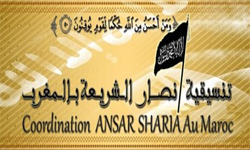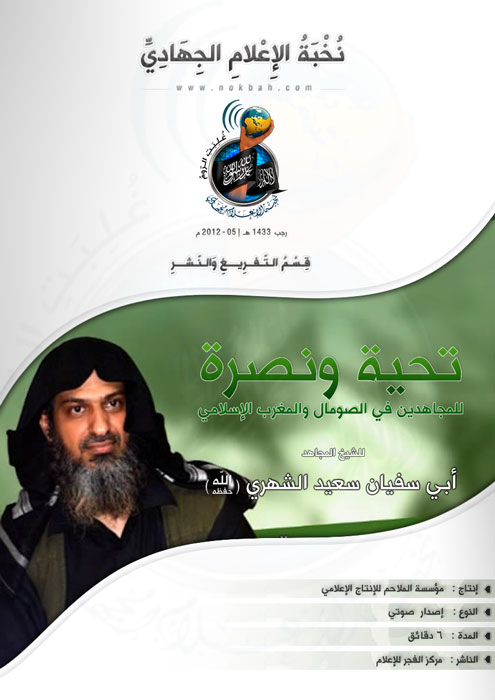
Click the following link for a safe PDF copy: The Bitter Truth- From the Detainees in Anṣār al-Sharī’ah in the Maghrib (Morocco)
_________
To inquire about a translation for this statement for a fee email: [email protected]

Click the following link for a safe PDF copy: The Bitter Truth- From the Detainees in Anṣār al-Sharī’ah in the Maghrib (Morocco)
_________
To inquire about a translation for this statement for a fee email: [email protected]
UPDATE 11/25/12 9:46 PM: Here is an Arabic transcription of the below audio message:

Abū Faḍl ‘Umar al-Ḥadūshī — “Oh Youth of the Awakening Beware of Rumors” (Ar)
___________
—

Abū Faḍl ‘Umar al-Ḥadūshī — “Oh Youth of the Awakening Beware of Rumors”
___________
To inquire about a translation for this audio message for a fee email: [email protected]

Abū Faḍl ‘Umar al-Ḥadūshī — “Missteps of the ‘Ulamā'”
__________
To inquire about a translation for this audio message for a fee email: [email protected]

Abū Faḍl ‘Umar al-Ḥadūshī — “In Response to Some Secularists in Tunisia- Who Denied That the Qur’ān Said the Prohibition on Alcohol is a Definitive Proof!!”
__________
To inquire about a translation for this audio message for a fee email: [email protected]

There is a new trend sweeping the world of jihadism. Instead of adopting unique names, groups increasingly prefer to call themselves ansar, Arabic for “supporters.” In many cases, they style themselves Ansar al-Sharia — supporters of Islamic law — emphasizing their desire to establish Islamic states. Yet despite the fact that these groups share a name and an ideology, they lack a unified command structure or even a bandleader like the central al Qaeda command (or what’s left of it), thought to be based in Pakistan. They are fighting in different lands using different means, but all for the same end, an approach better suited for the vagaries born of the Arab uprisings.
The name Ansar al-Sharia shot into the news last week in the aftermath of the attack on the U.S. consulate in Benghazi, Libya, when the local organization Katibat Ansar al-Sharia was accused of perpetrating it — charges the group denied. Many reports seem to have confused Benghazi’s Ansar al-Sharia with another Libyan group, based in Derna.
The naming trend actually started in Yemen, when al Qaeda in the Arabian Peninsula (AQAP), the powerful and ambitious local al Qaeda branch, established the front group Ansar al-Sharia in Yemen in April 2011. It is possible this was born out of Osama bin Laden’s musings over whether to rebrand al Qaeda. None of the names in the documents captured from the late al Qaeda leader’s compound mentioned Ansar al-Sharia as a potential example, however. More recently, one of the preeminent global jihadi ideologues, Shaykh Abu al-Mundhir al-Shinqiti, put his stamp of approval on the new wave of Ansar al-Sharia groups.
Shinqiti, who is of Mauritanian origin, published an article in mid-June titled “We Are Ansar al-Sharia,” calling Muslims to establish their own dawa (missionary) Ansar al-Sharia groups in their respective countries and then to unite into one conglomerate. It should be noted that most of the Ansar al-Sharia groups were already created beforehand. The most prominent of these organizations are the ones in Yemen, Tunisia, and Libya, along with newer versions in Egypt and Morocco to a lesser extent.
The rise of these Ansar al-Sharia groups points to an end of al Qaeda’s unipolar global jihad of the past decade and a return to a multipolar jihadosphere, similar to the 1990s. One key difference, however is that jihadi groups are now more ideologically homogenous — in the 1990s, jihadis thought locally and acted locally, while many now talk globally and act locally. These newer groups are also more interested in providing services and governance to their fellow Muslims.
Distinguishing between these differing groups is crucial for better understanding the new landscape of the Middle East and North Africa, as well as the trajectory of new salafi-jihadi groups that are not necessarily beholden to al Qaeda’s strategies or tactics. Although there are no known formal or operational links between these disparate organizations, it is possible they may try to link up in the future based on ideological affinity and similar end goals. For now, though, conflating them would be premature. Here’s a guide to the major groups going by this name.
Click here to read the rest.
UPDATE 9/21/12 12:23 PM: Here is an English translation of the below Arabic statement:

Click the following link for a safe PDF copy: al-Qā’idah in the Islamic Maghrib — “Except the Beloved Oh Worshipers of the Cross” (En)
__________
—

Click the following link for a safe PDF copy: al-Qā’idah in the Islamic Maghrib — “Except the Beloved Oh Worshipers of the Cross”
_________

Click the following link for a safe PDF copy: Anṣār al-Sharī’ah in the Maghrib — “Statement #1- Preliminary Doctrinal Paper”
_________
To inquire about a translation for this statement for a fee email: [email protected]

Click the following link for a safe PDF copy: al-Ḍarāghim Media Foundation — “Official Launch”
__________
To inquire about a translation for this statement for a fee email: [email protected]
UPDATE 7/27/12 11:29 AM: Here is an English translation of the below Arabic audio-visual message and transcription:

_________
—
UPDATE 5/24/12 1:37 PM: Here is an Arabic transcription of the below audio-visual message:

Click the following link for a safe PDF copy: Shaykh Abū Sufyān al-Azdī (Sa’īd al-Shehrī) — “Greetings and Support for the Mujāhidīn in Somalia and the Islamic Maghrib” (Ar)
__________
—

___________

Click the following link for a safe PDF copy: Ḥāmid Bin ‘Abdullah al ‘Alī — %22The Islamists- The New Rulers And The Challenges They Will Face%22
________